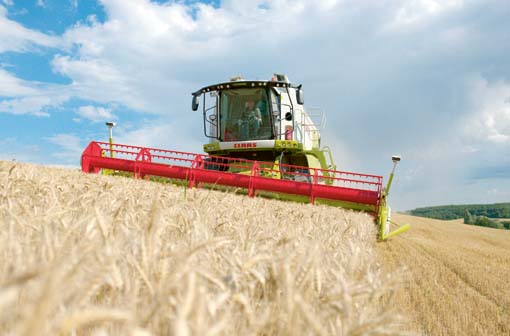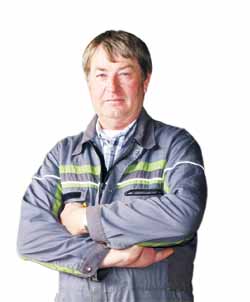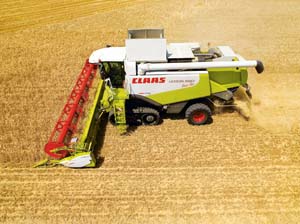Combines: fewer isn’t always better

Chalke Valley Farming was formed five years ago when three neighbouring farmers decided the economies of scale created by farming larger units would result in financial benefits for all concerned.
Based at Stratford Tony, near Salisbury, Wiltshire, the company now has a membership of five farmers and a total of 2,400ha (6,000 acres), of which 2,000ha (5,000 acres) is used to grow combinable crops.
 Heading the operation and taking overall responsibility for the running of the farms is managing director Steve Hockley. He points out that there are substantial savings to be made when working as a co-operative.
Heading the operation and taking overall responsibility for the running of the farms is managing director Steve Hockley. He points out that there are substantial savings to be made when working as a co-operative.
“Instead of there being, say, five sprayers, five drills or five cultivators, there is just one of each,” he says. “And rather than having to employ 10 people we employ only four.”
All of which makes good financial sense – the investment in machinery is reduced, despite the need for larger machines capable of working large acreages.
For example, the main tractor is a 360hp Claas Xerion 3800, which is used for all primary cultivation work, and this giant is supported by an Axion 810, an Arion 620, a Fendt 820 Vario and a John Deere 8430.
When it comes to the number of combines though, the situation is not quite as clear cut. While there is a need for adequate capacity, the block cropping system employed by the company puts a different slant on the situation.
Cropping on the predominantly chalk soils comprises just oilseed rape, winter wheat and spring barley, all in equal measures.
“We have established a simple and, we believe, efficient rotation that calls for three blocks of land to be moved around so that there are always about 1,650 acres of each,” he explains. “The spring barley not only eases our autumn workload, but also allows about 1,200 acres of land to be ploughed each year.”
Simple as this cropping system is, it does create a big peak in workloads at certain times of the year, particularly when it comes to harvesting – more so than if there had been a wider span of crops with a broader spread of harvesting dates. And it is the harvest workload that has led to some intense discussions among the five company members – the company’s directors.
While combine makers say their machines will be capable of harvesting a given number of hectares during a season, it is unlikely these claims make sense when a large area of crop all needs to be harvested at the same time.
“I have no doubt there are combines out there with the capacity to cope with our acreage should we have a succession of different crops. But it’s not quite the same when say, 1,650 acres of oilseed rape needs to be harvested,” he says.
 Last season, the company used two Claas Lexion combines – a 580 on tracks with GPS guidance, yield mapping and a 9m header, and a 570 Montana, which has self-levelling capability and is useful on the hillier areas of the farms. The 580 was new last year and the Montana, with its Laser Pilot guidance and 7.5m header, has worked for three seasons.
Last season, the company used two Claas Lexion combines – a 580 on tracks with GPS guidance, yield mapping and a 9m header, and a 570 Montana, which has self-levelling capability and is useful on the hillier areas of the farms. The 580 was new last year and the Montana, with its Laser Pilot guidance and 7.5m header, has worked for three seasons.
“The point is we don’t have enough harvesting capacity for our three-crop system,” says Mr Hockley. “According to our local meteorological office, this area of the UK provides an average of 220 hours of harvesting weather each season and our two combines were each clocking up 290 hours.
“This means two things: first is that we were having to harvest for some of the time in less than ideal weather conditions, and the second was that a percentage of the crops were being harvested late and quality suffered.”
For the spring barley, which is aimed at the malting market, any loss of grain quality can mean severe financial penalties if it has to be sold for feed, he adds. “I reckoned that to be on top of the job, we needed the combine capacity to cut another 60 acres per day,” he explains. “And initially, I wasn’t sure just how we should set about achieving this.”
There was a choice. One was to change the Lexion 580 for the larger 770 which, while being an attractive option, would still have only increased capacity by 25 acres/day – still too low. And there was also no wish to dispose of the services of the Montana.
“We did the sums and found that to swap the 580 for a 770 would mean paying out £190,000,” he says. “We seriously considered taking this route, but then I had another thought and that was to purchase a third combine to provide the extra capacity.”
Demand for used, smaller capacity combines is high and hunting down a suitable machine was not that easy. But, eventually, a three-year-old, low-hour Claas Lexion 550 was found and purchased for £137,000 – a saving of £60,000 on the 770 option.
Mr Hockley believes the use of three combines will offer further advantages in that they will allow harvesting to proceed more easily without stores having to cope with vast quantities of grain.
“Our handling and storage facilities are not geared to cope with the high volumes modern combines can produce, so if we have the combines working in different areas with each feeding into a different store, it will make life easier yet mean we are still harvesting at the required rate,” he says.
In terms of annual running costs, he puts the total figure for each combine at £53,000 for the 580, £40,000 for the Montana 570 and £30,000 for the 550. This figure includes the cost of the Claas Maxi Care service plan, fuel, depreciation and labour.

